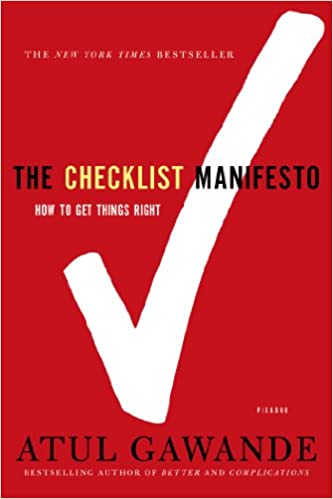Every single success story we’ve had at FLEXEM can be linked directly or indirectly to a checklist. Yet, these simple (but incredibly powerful) ‘magic wands’ seem to face resistance at most workplaces (and private lives) at a deeper level than mere ‘laziness’.
At Flexem we now foster the mindset of the Airline Captain ahead of Art Critics, Sponges and the like (more below). This way, we are be able to cruise at high altitudes.
This excerpts from the Checklist Manifesto explains it all.
Excerpt from The Checklist Manifesto (How to get things right) by Atul Gawande
(Bold emphasis added)
“…we should also be ready to accept the virtues of regimentation… The opportunity is evident in many fields—and so also is the resistance.
Recently, I spoke to Mohnish Pabrai …one of three [huge] investors …who have taken a page from medicine and aviation to incorporate formal checklists into their work. They don’t time the market…They do intensive research, look for good deals…The ideas can bubble up from anywhere…
[Pabrai] made sure to take his time when studying a company. The process could require weeks. And he did very well following this method—but …also made mistakes, some of them disastrous…That’s bound to happen. Risk is unavoidable in Pabrai’s line of work…[but] these were mistakes in the sense that he had miscalculated the risks involved…
…So he devised a written checklist.
Without the checklist, Pabrai said, he could not have gotten through a fraction of the analytic work or have had the confidence to rely on it. A year later, his investments were up more than 160 percent on average. He’d made no mistakes at all.
What makes these investors’ experiences striking to me is not merely their evidence that checklists might work as well in finance as they do in medicine. It’s that here, too, they have found takers slow to come. In the money business, everyone looks for an edge. If someone is doing well, people pounce like starved hyenas to find out how. Almost every idea… Every idea, that is, except one: Checklists.
I asked Cook how much interest others have had in what he has been doing these past two years. Zero, he said-or actually that’s not quite true. People have been intensely interested in what he’s been buying and how, but the minute the word checklist comes out of his mouth, they disappear. Even in his own firm, he’s found it a hard sell.
“I got pushback from everyone. It took my guys months to finally see the value,” he said…
“I find it amazing other investors have not even bothered to try,” he said. “Some have asked. None have done it.” The resistance is perhaps an inevitable response. Some years ago, Geoff Smart, a Ph.D. psychologist who was then at Claremont Graduate University, conducted a revealing research project. He studied fifty-one venture capitalists, people who make gutsy, high-risk, multimillion-dollar investments in unproven start-up companies…
Venture capitalists bet on wild-eyed, greasy-haired, underaged entrepreneurs pitching ideas that might be little more than scribbles on a sheet of paper or a clunky prototype that barely works…
Finding a good idea is apparently not at all hard. Finding an entrepreneur who executes a good idea is a different matter entirely… Such people are rare and extremely hard to spot.
Smart identified half a dozen different ways the venture capitalists he studied decided whether they’d found such a person.
These were styles of thinking, really. He called one type of investor the ‘Art Critics.” They assessed entrepreneurs almost at a glance…—intuitively and based on long experience. “Sponges” took more time gathering information…Then they went with whatever their guts told them…
The “Prosecutors” interrogated entrepreneurs aggressively, testing them with challenging questions … “Suitors” focused more on wooing people than on evaluating them. “Terminators” saw the whole effort as doomed to failure skipped the evaluation part…
Then there were the investors Smart called the ‘Airline Captains”. They took a methodical, checklist-driven approach to their task. Studying past mistakes and lessons from others in the field, they built formal checks into their process. They forced themselves to be disciplined and not to skip steps, even when they found someone they “knew” intuitively was a real prospect.
Smart next tracked the venture capitalists’ success over time. There was no question which style was most effective—and by now you should be able to guess which one. It was the Airline Captain, hands down. Those taking the checklist-driven approach had a 10 percent likelihood of later having to fire senior management for incompetence … The others had at least a 50 percent likelihood.
The results showed up in their bottom lines, too. The Airline Captains had a median 80 percent return on the investments studied, the others 35 percent or less…
The most interesting discovery was that, despite the disadvantages, most investors were either Art Critics or Sponges—intuitive decision makers instead of systematic analysts. Only one in eight took the Airline Captain approach. Now, maybe the others didn’t know about the Airline Captain approach. But even knowing seems to make little difference …
But when I asked him, now that the knowledge is out, whether the proportion of major investors taking the more orderly, checklist-driven approach has increased substantially, he could only report,’No. It’s the same’”
We don’t like checklists. They can be painstaking. They’re not much fun. But I don’t think the issue here is mere laziness. There’s something deeper, more visceral going on when people walk not only from saving lives but from making money. It somehow feels beneath us to use a checklist, an embarrassment. It runs counter to deeply held beliefs about how the truly great among us-—those we aspire to be—handle situations of high stakes and complexity. The truly great are daring. They improvise. They do not have protocols and checklists.
Maybe our idea of heroism needs updating.”


